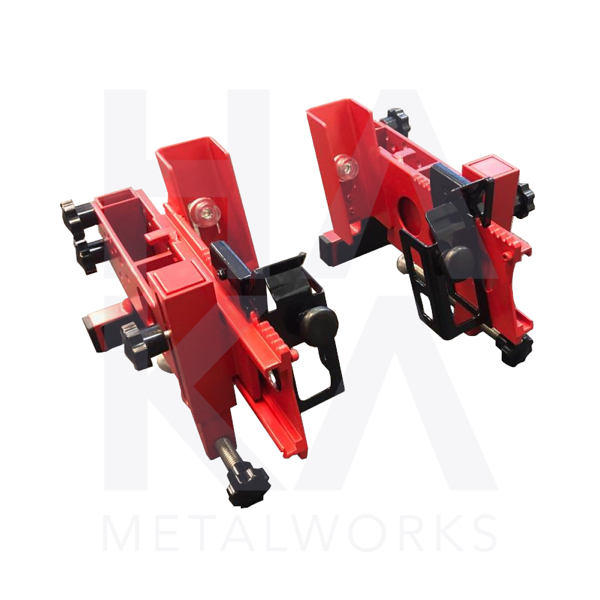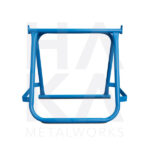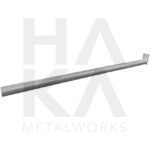Toplocker
Patented and unique ladder securing system!
- The Toplocker prevents the ladder from slipping sideways
- Fits all regular brands with rectangular ladder beams
- To be used for ladder use against gutters, dormers,
parapets with the exception of mast gutters and plastic gutters - Thanks to the unique construction, the ladder beams move with the climbing and descending of the ladder
- This ladder securing system is registered as a health and safety friendly aid, weight set 2.9 kg
- Use only ladder support according to the Toplocker user manual
Patented and unique ladder securing system!
- The Toplocker prevents the ladder from slipping sideways
- Fits all regular brands with rectangular ladder beams
- To be used for ladder use against gutters, dormers,
parapets with the exception of mast gutters and plastic gutters - Thanks to the unique construction, the ladder beams move with the climbing and descending of the ladder
- This ladder securing system is registered as a health and safety friendly aid, weight set 2.9 kg
- Use only ladder support according to the Toplocker user manual
Specifications Ladder clamp:
- Dim. LxWxH: 270x100x230mm
- Weight: 1429 grams per Toplocker
- Color: Signal red
- Maximum side load: 20kg per Ladder console
ATTENTION! Only use the Toplocker in accordance with the Toplocker manual and in combination with ladders that comply with the commodities act (decree on portable climbing equipment) and the Dutch standard NEN2484 in accordance with occupational health and safety regulations! Do not use the Ladder Hook in case of (visible) damage.
Health and safety effects:
In Europe, about half a million employees every year from a ladder, scaffolding or roof, stairs and floor holes have been a major problem for many years. Nearly six hundred painters and plasterers fall every year. In 2002 the trade union FNV Bouw started a campaign called Give the ladder a staircase to make working at heights safer.
Since your 2001, a European directive on working at heights has been in force, which restricts the use of ladders. The European Commission has adopted the separate “Working at height” guideline to reduce the risk of falling. Painters and window cleaners are no longer allowed to just use a ladder for their work. An exception may only be made if there is absolutely no other option. By 2004 all Member States must comply with the requirements. As a result of the introduction of this European directive into Dutch legislation, employees are no longer allowed to work on ladders from 1 July 2004. The cabinet decided in March that they must use scaffolding or aerial work platforms for their work.
According to European directives, a ladder may only be worked if:
- the job is short;
- a security risk is very small;
- the weather does not jeopardize safety;
- personnel have received safety training;
- there is no alternative.
FNV Bouw
FNV Bouw demands a clearer interpretation of the European directive and calls for better information for employees who work at heights. This mainly concerns the question of when an exception may be made to the prohibition of the ladder as a workplace. The trade union and its members have proposed a number of measures to implement the European directive concretely for the Netherlands and has advocated the following measures to the government and employers’ organizations:
1. As a rule, the ladder may no longer be used as a workplace. Exceptions to this rule are only allowed if the safety risks have been listed first. A ladder may only be used when it has been determined by the Risk Inventory that:
- there are no major risks “
- the job involves a working height of less than six meters;
- also the job does not take more than three hours a day (and no more than two consecutive hours);
- the size of the material is no more than one square meter;
- extra measures have been taken to prevent the ladder from slipping;
- no material heavier than 2.5 kilos is included in the ladder;
- the employee does not have to reach beyond an arm’s length and can therefore stand with two feet on the rungs of the ladder,
2. Every employee in the finishing sector must have followed the Working at height course, which, among other things, focuses on drawing up the Risk Inventory.
3. Work meetings must be held in every company so that the safety risks between employer and employees can be discussed.
Safe use of the ladder
Sometimes you cannot avoid the ladder. Especially self-employed professionals will not be able to do without it. Because erecting a scaffolding on your own is a hopeless task. It is cumbersome and expensive. If you don’t have any alternatives and still need to climb the ladder, make sure it’s safe.
Instructions for setting up and using the ladder safely
- There must be sufficient free space for the placement of a ladder and use with wind force 6 or higher is not allowed.
- The ladder must be set up at an angle of approximately 75 degrees;
- The ladder must not be able to sink or slip at the bottom (if necessary, be provided with a stability beam)
- A ladder must be secured at the top against slipping sideways (if necessary secured with a rope);
- A ladder must protrude at least one meter above the place to which it gives access. When getting off the ladder at a height, a
- be valid support;
- Do not place a ladder on an inclined plane, soft, uneven or slippery surface on a table or box, back to front or upside down;
- Keep sports and ladder shoes clean;
- Climb a ladder facing the ladder using two hands;
- Always keep the access of the ladders clear of obstacles, if necessary mark with safety barriers;
- Close or block a door if you need to place a ladder in front of a door;
- Never place metal ladders near live bare parts; keep a distance of at least two meters or use a
- insulated ladder;
- Never reach too far beyond the ladder and never support with one foot on (for example) a window frame or sill;
- Do not place a ladder directly against a window; in this case use cross braces;
- Never climb a ladder or stairs (without platform) higher than the fourth step from the top;
- Ladders must not be left unattended.
Toplocker ladder clamp for securing ladders
- 8000.0000 | HAKA Toplocker set left and right
Do you want more information about the toplocker? contact us or make a quotation with the button above.



